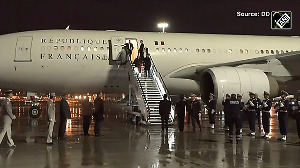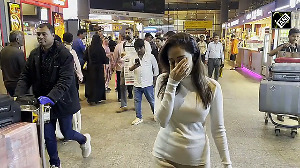Badiali who worked for Italian low-cost carrier MyAir, apart from a two year stint in Jet Airways in the early 1990s, talks to Surajeet Das Gupta and Anirban Chowdhury about his plans for the airline and the tough times in the aviation industry.
You are the smallest airline in an industry which is facing huge losses, investors are wary of putting in money and there is surplus capacity. How do you survive?
There is no doubt that India is a large growth market in the long term. But there are major problems related to aviation turbine fuel (ATF), ATC, infrastructure, shortage of pilots and so on. Taking all of this into account, I would call our approach one of maintaining long-term sustainability - a step-wise, organised growth with a focus on efficiency.
Our strategy has been to be a strong player around a hub rather than spread all over the country and grow step by step. That is why we have a disproportionate 10 per cent market share of the Mumbai market, though our all-India share is 4 per cent. We want to defend our position in the Mumbai-Delhi sector, where we have nine flights a day, by increasing the number of direct flights.
The next step will be to identify another hub for our operations. That is necessary because we are expanding our current fleet strength of six aircraft to 11 by March next year, and due to infrastructure constraints in Mumbai, we have to look elsewhere. We are looking at places like Chennai, Hyderabad and Bangalore. Chennai is a great market in terms of its sheer size.
Bangalore and Hyderabad are excellent in terms of the new infrastructure going to be in place because of the two new greenfield airports, though Bangalore is a hub for our competitors. Delhi, however, has its problems because of infrastructure constraints. In the east, we would definitely like to look at Kolkata. We will study a destination for three to four months before making it a hub. Several things have to be taken into account. If you make a destination your hub, you will have to get parking slots, space to park your aircraft, among other things.
You are not as aggressive as, say, Simplifly Deccan which has picked up a large market share. Also, is it tough to survive when you are so small?
It is very easy to expand aggressively and spread your network all across the country. But who takes care of the costs? Our strategy is that it is much better to first consolidate what you have, and then move on. An airline has to spend a lot to open a new route. More bases and destinations would mean lesser utility of costs.
But when you increase flights in your existing network, it has a two-fold benefit. You can spread you costs across different overheads. So, if you deploy three flights from the same place you can utilise your crew, fuel and aircraft more, leading to positive yields and thus profitability.
To answer your second question, it depends on what size you can expand to while maintaining yields. I can induct 20 extra aircraft and deploy all of them for operations. However, my flights will only enjoy 40 per cent occupancy. Where do my costs go then?
Carriers have recently been trying to increase fares to reduce losses. However, Go Air still has the lowest fares in the industry. Is it a conscious policy?
The pricing game will always depend on what others are doing. And as long as things stand that way, there will always be pressure on pricing. We will decrease prices when our competition does. Speaking specifically about Go Air, our strategy has been to garner as much load factor as possible. We need to consolidate our market.
Apart from having more than 80 per cent market share, we also have 0.75 per cent market share per aircraft which is the highest in the industry, the lowest being 0.25 and the second highest being 0.68. But as we expand our market, there will be changes in the scenario. Accordingly, our prices will also go up to an extent. But we will continue to offer very competitive fares.
Will there be more consolidation, given the huge surplus capacity?
I think the consolidation phase is over. We have already seen a lot of consolidation in the sector. Today, there are three low-cost carriers (LCCs) which will primarily concentrate on the domestic sector, while full-service carriers would look at international routes. Then, of course, there are the regional carriers which are going to come, but they will take some time to make a mark on the feeder routes because of the infrastructural problems that exist.
However, there is a lot to be exploited in the domestic sector, especially by LCCs. In India, for instance, it is not the small and medium enterprises (SMEs) that are going for LCCs. Large companies are also making sure that their middle-management employees travel in budget airlines, and this process will become more marked if we go through a slowdown.
Will lease rentals and prices of aircraft come down?
Yes, there have been so many big orders for aircraft last year globally. In my opinion, there will definitely be a slowdown in demand, considering the global slowdown fears, resulting in the prices of aircraft coming down. As far as we are concerned, we are not making any fresh orders, we'd rather wait and watch than commit to a higher price.
While you are still not making money, you are looking for strategic investors. What is the future story that you are selling?
We are taking cautious steps towards expansion. We will continue to have high level of utilisation. We expect our market share to go up to 10-15 per cent by 2012 from the current 4.5 per cent. By that time we should have 31 aircraft. One of the main deterrents will be rising fuel prices which will constantly go up. But on the optimistic side, we expect that its effect will get neutralised by a reduction in the sales tax on ATF fuel. Kerala and Andhra Pradesh have done a good thing. I expect other states to follow. There are other factors too, but we expect to break even in 2009.
You have been pushing for red-eye operations (late night and early morning flights). How does that help?
Yes, we are looking at flights which will be timed around 4.30 or 5.00 am and primarily in the Mumbai-Delhi sector. This is a model followed in several countries.
These flights lead to higher utilisation of resources and will attract traffic also. Also, the government can get over infrastructural problems in airports like Mumbai. We are probably going to price it lower than our usual rates.







 © 2025
© 2025